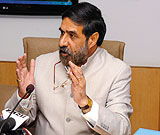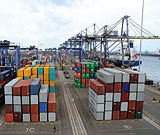|
A total of 118 press notes issued in the past were rescinded on March 31 by the Government, and instead one consolidated, and simplified document was introduced to announce the new FDI policy aimed at doubling the automatic foreign investment limit. Investors, finally, can now consult just one document, instead of having to grapple with several pieces of information.
The thinking within the Government is that investment inflows can revitalize agriculture and and also provide an impetus to domestic defence production. Thus far, in spite of 26 per cent FDI being allowed in defence production, foreign investors have mostly stayed away. Now, the Department of Industrial Policy and Promotion (DIPP) of the Ministry of Commerce and Industry is ready to allow FDI up to 49 per cent in defence production.
|
Minister for Commerce and Industry Anand Sharma interacting with journalists during the release of the consolidated FDI policy on March 31. “We would like to bring in technology and investments. At the same time we will have to consider sensitivities of other departments like defence,” he said |

|
“We would like to bring in technology and investments. At the same time we will have to consider sensitivities of other departments like defence,” says Anand Sharma, Minister for Commerce and Industry. Inter-ministerial discussions on the likely FDI changes have already begun.
The new policy document states clearly that the Indian Government wishes to attract and promote productive FDI from NRIs and others in activities which significantly contribute to industrialization and socio-economic development. FDI supplements domestic capital and technology. The International Monetary Fund (IMF) and the Organization for Economic Cooperation and Development (OECD) define FDI as cross border investment made by a resident in one economy (and, therefore, the direct investor) in an enterprise that is in an economy other than that of the direct investor. The objective of the foreign investor is to establish a lasting interest in the economy of his choice.
FDI equity inflow into India rose 15.4 per cent in February over the corresponding month last year to USD 1.72 billion. Overall, cumulative FDI inflows for April-February stood at USD 24.68 billion. This, however, is 2.8 per cent lower than the USD 25.39 billion for the corresponding period last year. “There has a been a global shrinkage in FDI investments, and OECD countries are witnessing massive declines. So India’s FDI inflow needs to be seen in that context,” Sharma said.
In spite of the decline, the Government is confident that the FDI equity inflows of last financial year (USD 27.31 billion) will be matched. The Government has set a target of achieving USD 50 billion annually by 2012 and USD 75 billion by 2014. “We are well on track to meet the targets,” the Commerce Minister said.
The new policy document does not change substantially the foreign investment rules or FDI limits applicable to various sectors. In case of wholesale trading, though, new guidelines have been spelt out. Other areas related to policy such as foreign investment in limited liability partnerships (LLPs), issuance of partly paid shares / warrants are still under discussion in the Government.
Up until now, the practice has been to issue individual Press notes to notify changes pertaining to cross border investment, policy liberalization, policy rationalization, foreign technology collaboration and industrial policy. From now on, a new document on regulatory framework will be issued every six months that will incorporate and reflect all changes in regulations.
| Category |
FDI Equity allowed (%) |
|
|
Agriculture and Animal Husbandry
(Floriculture, horticulture, development of seeds, animal husbandry,
pisciculture, aquaculture and cultivation of vegetables and
mushrooms
under controlled conditions and services related to agro and allied
sectors,
tea sector, including tea plantations under Government route) |
26, 100 |
|
|
Industry
(Mining and exploration of metal and non-metal ores, including diamonds,
gold, silver and precious ores) |
100 |
|
|
Manufacturing
(Distilling and brewing of alcohol, manufacture of cigar and cigarettes,
processing and warehousing of coffee and rubber, manufacture of drugs and
pharmaceuticals including those involving use of recombinant technology,
manufacture of hazardous chemicals, industrial explosives) |
100 |
|
|
Power
(Electric generation, transmission, distribution and trading of power under
automatic route in sectors based on hydro-electricity, coal / lignite, oil,
gas, and non-conventional energy)
|
100 |
|
|
Advertising and Films
(Film financing, production, distribution, exhibition, marketing and
associated activities related to the film industry) |
100 |
|
|
| Civil Aviation |
49, 74, 100 |
|
|
| Private Sector Banking |
74 |
|
|
| Public Sector Banking |
20 |
|
|
| Broadcasting |
20, 49, 74, 100 |
|
|
Construction and Maintenance
(Roads, rail-beds, bridges, tunnels, pipelines, ropeways, runways, waterways
and water reservoirs, hydroelectric projects, power plants and industrial plants) |
100 |
|
|
Ports and Harbours
(container terminals, cargo berths, warehousing, freight stations, tank farms,
cranes, handling equipment, setting up of captive power plants, dry docking,
ship repair facilities, leasing of floating crafts, captive facilities for
port-based industries) |
100 |
|
|
| Metro |
100 |
|
|
Townships and Infrastructure Projects
(Townships, housing, built-up infrastructure and construction-development projects) |
100 |
|
|
| Health and Medicare |
100 |
|
|
| Hotels and Tourism-related industry |
100 |
|
|
| Industrial Parks |
100 |
|
|
| Insurance |
26 |
|
|
| Non-banking finance companies |
100 |
|
|
| Venture Capital Fund |
100 |
|
|
| Petroleum and Natural Gas Sector
|
100 |
|
|
| Print Media |
26, 100 |
|
|
| Security agencies |
49 |
|
|
| Satellites |
74 |
|
|
| Telecommunication services |
74 |
|
|
| Transport and transport support services |
100 |
FDI sector-wise
 Agriculture and Animal Husbandry: At present 100 per cent FDI is allowed under automatic route in floriculture, horticulture, development of seeds, animal husbandry, pisciculture, aquaculture and cultivation of vegetables and mushrooms under controlled conditions and services related to agro and allied sectors. Also, 100 per cent FDI is allowed in the tea sector, including tea plantations under Government route provided 26 per cent of the equity of the company is divested in favour of an Indian
partner within a period of 5 years. Agriculture and Animal Husbandry: At present 100 per cent FDI is allowed under automatic route in floriculture, horticulture, development of seeds, animal husbandry, pisciculture, aquaculture and cultivation of vegetables and mushrooms under controlled conditions and services related to agro and allied sectors. Also, 100 per cent FDI is allowed in the tea sector, including tea plantations under Government route provided 26 per cent of the equity of the company is divested in favour of an Indian
partner within a period of 5 years.
Industry: At present 100 per cent FDI is allowed under the automatic route in mining and exploration of metal and non-metal ores, including diamonds, gold, silver and precious ores, but excluding titanium bearing minerals and its ores. Also, 100 per cent FDI is allowed under the automatic route in coal and lignite mining for captive consumption of power projects, iron and steel, cement units. The same is allowed for setting up coal processing plants like
washeries.
 Manufacturing: At present, 100 per cent FDI is allowed under the automatic route in distilling and brewing of alcohol, manufacture of cigar and cigarettes, processing and warehousing of coffee and rubber, manufacture of drugs and pharmaceuticals including those involving use of recombinant technology, manufacture of hazardous chemicals, industrial explosives. Also, up to 26 per cent FDI under the Government route is permitted for defence production, subject to various forms of scrutiny. There would be a 3-year lock-in for transfer of equity from one foreign investor to another, including
NRIs. Manufacturing: At present, 100 per cent FDI is allowed under the automatic route in distilling and brewing of alcohol, manufacture of cigar and cigarettes, processing and warehousing of coffee and rubber, manufacture of drugs and pharmaceuticals including those involving use of recombinant technology, manufacture of hazardous chemicals, industrial explosives. Also, up to 26 per cent FDI under the Government route is permitted for defence production, subject to various forms of scrutiny. There would be a 3-year lock-in for transfer of equity from one foreign investor to another, including
NRIs.
 Power: Up to 100 per cent FDI is permitted for electric generation, transmission, distribution and trading of power under automatic route in sectors based on hydro-electricity, coal / lignite, oil, gas, and non-conventional energy. All forms of generation, transmission and distribution of electricity in atomic power plants are excluded, as it is reserved for the public sector. Power: Up to 100 per cent FDI is permitted for electric generation, transmission, distribution and trading of power under automatic route in sectors based on hydro-electricity, coal / lignite, oil, gas, and non-conventional energy. All forms of generation, transmission and distribution of electricity in atomic power plants are excluded, as it is reserved for the public sector.
Advertising and Films: At present, 100 per cent FDI under automatic route is allowed in advertising sector and film industry including film financing, production, distribution, exhibition, marketing and associated activities related to the film industry.
Civil Aviation: At present, up to 100 per cent FDI is allowed under the automatic route in Greenfield airport projects. In existing projects investment up to 100 per cent is allowed, with 74 per cent under the
 automatic route and beyond via the Government route. In air transport services, and scheduled domestic airlines, FDI up to 49 per cent is permitted while NRI investment up to 100 per cent is allowed in automatic route. In case of non-scheduled air transport services, and non-scheduled, chartered and cargo airlines, FDI up to 74 per cent and investment by NRI up to 100 per cent is allowed. Up to 100 per cent FDI is allowed for on the automatic route, subject to DGCA approval on helicopter services / seaplane services. In ground handling services, FDI up to 74 per cent is permitted and investment up to 100 per cent by NRIs is allowed. FDI up to 100 per cent is allowed in the automatic route for maintenance and repair organizations, flying training institutes and technical training institutions. automatic route and beyond via the Government route. In air transport services, and scheduled domestic airlines, FDI up to 49 per cent is permitted while NRI investment up to 100 per cent is allowed in automatic route. In case of non-scheduled air transport services, and non-scheduled, chartered and cargo airlines, FDI up to 74 per cent and investment by NRI up to 100 per cent is allowed. Up to 100 per cent FDI is allowed for on the automatic route, subject to DGCA approval on helicopter services / seaplane services. In ground handling services, FDI up to 74 per cent is permitted and investment up to 100 per cent by NRIs is allowed. FDI up to 100 per cent is allowed in the automatic route for maintenance and repair organizations, flying training institutes and technical training institutions.
 Private Sector Banking: The FDI limit in private sector banks is 74 per cent including investment by FIIs. The aggregate foreign investment in a private bank from all sources (portfolio investments, FIIs, NRIs, OCBs, IPOs, private placements) can be a maximum of 74 per cent of the paid up capital of the bank. At all times, at least 26 per cent of the paid up capital will have to be held by residents, except in the case of a wholly-owned subsidiary of a foreign bank. Private Sector Banking: The FDI limit in private sector banks is 74 per cent including investment by FIIs. The aggregate foreign investment in a private bank from all sources (portfolio investments, FIIs, NRIs, OCBs, IPOs, private placements) can be a maximum of 74 per cent of the paid up capital of the bank. At all times, at least 26 per cent of the paid up capital will have to be held by residents, except in the case of a wholly-owned subsidiary of a foreign bank.
Public Sector Banking: FDI and portfolio investment in nationalized banks are subject to overall statutory limits of 20 per cent under Government route.
 Broadcasting: Foreign investment in terrestrial broadcasting (FM Radio) including FDI, portfolio investments and investments by NRIs and PIOs are permitted up to 20 per cent. Broadcasting: Foreign investment in terrestrial broadcasting (FM Radio) including FDI, portfolio investments and investments by NRIs and PIOs are permitted up to 20 per cent.
In case of cable network it is 49 per cent under Government route, for direct-to-home it is 49 per cent with a cap of 20 per cent on FDI. In case of headend-in-the-sky (multichannel downlinking and distribution of TV programme on C or Ku bands where in all pay channels are downlinked at a central facility such as a hub or a teleport and again uplinked to a satellite after encryption of channel), the cap on foreign investment is 74 per cent.
 FDI up to 100 per cent would be allowed under the Government route for up-linking a non-news and non-current affairs TV channel, while the cap is set at 26 per cent under Government route for news and current affairs channels. FDI up to 100 per cent would be allowed under the Government route for up-linking a non-news and non-current affairs TV channel, while the cap is set at 26 per cent under Government route for news and current affairs channels.
Construction and Maintenance: At present, 100 per cent FDI is allowed under automatic route in construction and maintenance of roads, rail-beds, bridges, tunnels, pipelines, ropeways, runways, waterways and water reservoirs, hydroelectric projects, power plants and industrial plants. The same is applicable for construction and maintenance of roads and highways offered on BOT basis, including collection of toll.
 Ports and Harbours: At present, 100 per cent FDI is allowed under automatic route for leasing of existing assets of ports, construction and maintenance of assets such as container terminals, cargo berths, warehousing, freight stations, tank farms, cranes, handling equipment, setting up of captive power plants, dry docking, ship repair facilities, leasing of floating crafts, captive facilities for port-based industries. Ports and Harbours: At present, 100 per cent FDI is allowed under automatic route for leasing of existing assets of ports, construction and maintenance of assets such as container terminals, cargo berths, warehousing, freight stations, tank farms, cranes, handling equipment, setting up of captive power plants, dry docking, ship repair facilities, leasing of floating crafts, captive facilities for port-based industries.
Metro: At present, up to 100 per cent FDI is permitted in the automatic route for mass rapid transport systems in all metropolitan cities, including commercial development of real estate.
 Townships and Infrastructure Projects: At present, FDI up to 100 per cent under the automatic route in townships, housing, built-up infrastructure and construction-development projects (which would include, but not be restricted to housing, commercial premises, hotels, resorts, hospitals, educational institutions, recreational facilities, city and regional-level infrastructure) is allowed subject to guidelines. FDI, however, is not allowed in real estate business. Townships and Infrastructure Projects: At present, FDI up to 100 per cent under the automatic route in townships, housing, built-up infrastructure and construction-development projects (which would include, but not be restricted to housing, commercial premises, hotels, resorts, hospitals, educational institutions, recreational facilities, city and regional-level infrastructure) is allowed subject to guidelines. FDI, however, is not allowed in real estate business.
Health and Medicare: At present, 100 per cent FDI is allowed under the automatic route.
 Hotels and Tourism-related industry: At present, 100 per cent FDI is allowed under the automatic route. This includes investment in restaurants, beach resorts, tourism complexes, travel agencies, units providing wildlife experience and adventure tourism, transport facilities for tourists and seminar / convention facilities. Hotels and Tourism-related industry: At present, 100 per cent FDI is allowed under the automatic route. This includes investment in restaurants, beach resorts, tourism complexes, travel agencies, units providing wildlife experience and adventure tourism, transport facilities for tourists and seminar / convention facilities.
Industrial Parks: At present, 100 per cent FDI is allowed under the automatic route subject to conditions for minimum capitalization, minimum area requirements and lock-in of original investment.
 Insurance: At present, FDI up to 26 per cent in the insurance sector is allowed under automatic route subject to necessary licenses from Insurance Regulatory and Development Authority. Insurance: At present, FDI up to 26 per cent in the insurance sector is allowed under automatic route subject to necessary licenses from Insurance Regulatory and Development Authority.
Non-banking finance companies: At present, 100 per cent FDI is allowed under the automatic route in merchant banking, under writing, portfolio management services, investment advisory services, financial consultancy, stock broking, asset management, venture capital, custodian services, factoring, credit-rating agencies, leasing and finance, housing finance, foreign exchange broking, money changing business, credit card business, micro credit, rural credit. All investments would be subject to minimum applicable capitalization norms.
Venture Capital Fund: A foreign venture capital investor can contribute up to 100 per cent of the capital of an Indian venture capital undertaking and is also in a position to set up a domestic asset management company to manage the fund.
 Petroleum and Natural Gas Sector: FDI up to 100 per cent under the automatic route is permitted in exploration activities of oil and natural gas fields, infrastructure related to the marketing of petroleum products, actual trading and marketing of petroleum products, petroleum product pipelines, natural gas / LNG pipelines, market study and formulation and petroleum refining in the private sector. This will be subject to the existing sectoral policy and regulatory framework in the oil marketing sector and the policy of the Government on private participation in exploration of oil and the discovered fields of national oil companies. Petroleum and Natural Gas Sector: FDI up to 100 per cent under the automatic route is permitted in exploration activities of oil and natural gas fields, infrastructure related to the marketing of petroleum products, actual trading and marketing of petroleum products, petroleum product pipelines, natural gas / LNG pipelines, market study and formulation and petroleum refining in the private sector. This will be subject to the existing sectoral policy and regulatory framework in the oil marketing sector and the policy of the Government on private participation in exploration of oil and the discovered fields of national oil companies.
Print Media: At present, up to 26 per cent investment by NRIs, PIOs, FIIs is permitted under the Government route for publishing of newspapers and periodicals dealing with news and current affairs. For publication of Indian editions of foreign magazines, dealing with news and current affairs, up to 26 per cent FDI under Government route is allowed. For publishing, printing of scientific and technical magazines/speciality journals/periodicals, 100 per cent FDI is permitted under Government route.
Security agencies: Foreign shareholding is presently restricted to a maximum of 49 per cent under Government route. To be eligible for a license under provisions of the Private Security Agencies (Regulation) Act, 2005, a firm cannot have a foreign director, or partner.
Satellites: At present, up to 74 per cent FDI is allowed under Government route, subject to sectoral guidelines of the Department of Space and
ISRO.
Telecommunication services: At present, FDI is limited to 74 per cent in telecommunication services—basic, cellular, unified access services, national / international long distance, V-Sat, public mobile radio trunked services (PMRTS), global mobile personal communications services and other value added services. For other service providers (OSPs) providing such facilities as call centres, business process outsourcing, telemarketing, tele-education, 100 per cent FDI is permitted. FDI up to 74 per cent is allowed for ISP with gateways, radio paging, end-to-end bandwidth.
 Transport and transport support services: At present, 100 per cent FDI under automatic route is allowed for transport across pipelines, ocean and water, inland waterways, and for support services such as operation of highway bridges, toll roads, vehicular tunnels, maintenance of piers, loading and discharging of vessels. Transport and transport support services: At present, 100 per cent FDI under automatic route is allowed for transport across pipelines, ocean and water, inland waterways, and for support services such as operation of highway bridges, toll roads, vehicular tunnels, maintenance of piers, loading and discharging of vessels.
Conclusion: The opportunities for NRIs and others loom large on the Indian horizon. With the Government having taken a futuristic view on FDI and having announced an annual target of USD 50 billion by 2012, this is the time to put one’s money where the huge Indian market
is.
|